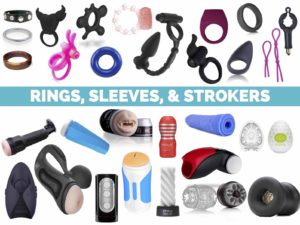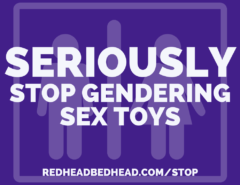It seems like not very long ago that I wrote a two-part series on the ridiculous practice of gendering sex toys but here we are again. Why? Because this particular niche which usually includes toys designed for penis and/or prostate stimulation has quite a few issues going on. Whether its the language used about them, (a quick peek at online sex shops yielded the following examples: “men’s toys” “male toys” “toys for men” “high-tech male sex toys” “male sex toys”), the consistently smaller selection, especially in comparison to toys available for clitoral or g-spot stimulation, or the misogyny inherent in the practice of labeling pleasure products “sex toys but, you know, manly” . There’s a lot going on. So today we’re going to look at all of these issues and, hopefully walk away from the whole thing never saying “men’s sex toys” again.

This graphic for my Intro to Toys class calls it like it is
Problem #1: Calling them “men’s” toys at all
Toys do not have genders. Now, as we are generally talking about toys for penis and/or prostate stimulation, let’s take a moment to remember that not all people with penises and/or prostates are men and not all men have penises and/or prostates. Calling these toys “mens” toys genders them unnecessarily and excludes a whole lot of people. The easy way to avoid the “unnecessarily gendered for no good reason” trap is to refer to toys according to what they do: Penis strokers, Prostate stimulators etc. For years I’ve listened to be people claim that not labeling things “his” and “hers” will “confuse” people. And I can’t, for the life of me, figure out how gendering toys is somehow less confusing than just calling them what they are! People respond to gendered toy divisions because they were taught to. They can likewise be taught to call toys why they are and/or label them by what they do.
Problem #2: Not devoting industry attention to them
Now, admittedly, over the last half-decade the selection of penis and prostate stimulation toys has exploded but often the selection is only a fraction of what is available for vaginal and clitoral stimulation. There are a couple of reasons for this (and we’ll get to a big one in a minute) but it doesn’t change the fact that for years these toys have gotten the shaft (pun 100% intended). I believe that this idea of “sex toys are pink and purple (btw, stop that) and made for vulvas and vaginas” is what drives the idea of “toys for penises and prostates are outliers” feeling.
Problem #3: Trying to replicate “sex”
Now, this is pervasive issue in ALL of sex toy world but there’s a particular angle that I want to look at here. For a long time the most prevalent form of toys designed for penis stimulation were strokers or as they used to more frequently called, “pocket pussies”. This keeps in line with the idea that effective toys mimic “sex”, specifically penis-in-vagina intercourse and possibly oral sex. This is problematic because it holds up those activities (especially P-in-V intercourse) as the “right” or “normal” routes to pleasure which is exclusionary towards people whose sexual interactions don’t include those activities (let’s be honest, this line of thinking is cisnormative/ heteronormative AF). It also feeds the pervasive idea that sex toys may “replace” partners/aren’t necessary for people with partners because they are sexual stand-ins. Finally — and I think this is a big one–it prevents toys users from thinking beyond the penis, something that, frankly, most people who have penises or who have sex with people who do could benefit from. The prostate is often referred to as the G-spot for folks with penises, it can be a tremendous source of pleasure and the whole “make it like boning!” approach to sex toys ignores that and, in my opinion, seriously short-changes users.
Problem #4: The inherent misogyny evident in how these toys are presented
So, about that whole “sex toys are pink and purple and largely aimed at folks with vulvas” thing. Hand in hand comes the idea that sex toys are “girly” or not masculine or some other such nonsense. This results in sex toys in general being dismissed as not “manly” and thus undesirable for folks who want to be masculine. In response to this, companies try to lure consumers with toys that are black or dark blue, toys that communicate “tough guy”, toys that say “like a sex toys but, you know, manly”. It’s the flip side of the “all toys must be pink or purple” issue that plagues toys intended for vaginal/clitoral use. When the toys aren’t being dressed up as the vibrator equivalent of a Ford F350, they are dressed up like, well, women. Full bodies or just disembodied vaginas and butts (sometimes, bafflingly, in 3/4 scale) with packaging that talks about how the user can “get her to do anything you want, no complaints!”. All of this saddles objects that should be a source of pleasure and empowerment for the users with a bunch of messages that encourage toxic masculinity and propagate the notion that toys, and indeed pleasure, are not part of a healthy sexuality. Additionally, at least one company has been called out in the past for gross, sexist, fat-phobic, horrible ad campaigns.
So, what can you do?
Well, a couple of things.
Watch your mouth! Seriously, pay attention to the language you use. Don’t identify toys based on the gender you think will utilize them. It’s easy, I promise. Refer to toys as what they are (“strokers”, prostate stimulators”, “cock rings” etc), or by what body parts they are designed for (“toys for penisies”, “prostate toys” etc).
Watch other mouths! Pay attention to the language companies you patronize use. Do they have a “men’s toys” section? Send them a message!
Don’t make assumptions! You don’t know what people want their toys to do, so don’t assume that you do. Remember that toys that recreate the P-in-V experience are not inherently “good” or “normal” so keep your mind open.
Smash the patriarchy! Toxic masculinity is bad for all of us, regardless of gender. Take that on and we’ll be able to take down toy-based misogyny.
This post contains a sponsored link. The opinions in it are, as always, my own.







